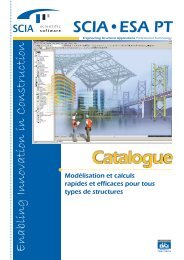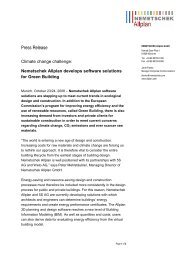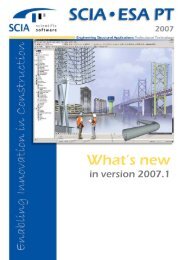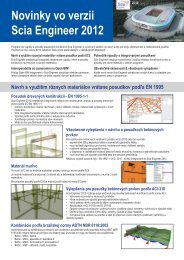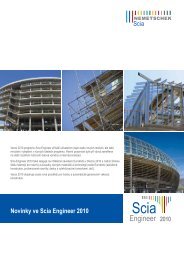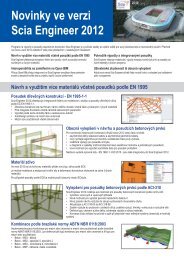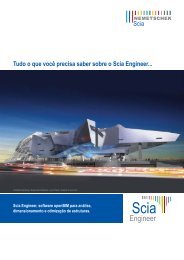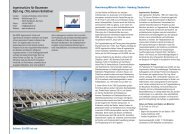VSH Turòa nad Bodvou - Nemetschek Scia
VSH Turòa nad Bodvou - Nemetschek Scia
VSH Turòa nad Bodvou - Nemetschek Scia
Create successful ePaper yourself
Turn your PDF publications into a flip-book with our unique Google optimized e-Paper software.
The presented project is about the realisation of special small vessels<br />
for very dangerous nuclear waste treatment. This project includes<br />
more than twenty different apparatus which were produced by<br />
the Slovak company TECHNOS Ltd. The main task for our firm was<br />
to perform the structural calculation of the vessel shells, nozzles<br />
and anchoring of the vessels. The input for the calculations was<br />
taken from data sheets and from the shop drawings of the vessels.<br />
All designed tanks were also checked for seismic resistance. The<br />
main aim of the calculations was to calculate the internal force<br />
stresses: in test condition, in normal operation and extraordinary<br />
operation, including also seismic effects.<br />
Structural calculation<br />
The design of the vessel is always connected with the use of<br />
relevant codes like ASME, AD-Merkblat and Eurocodes. Relevant<br />
codes usually calculate the mechanical resistance of the parts of<br />
the vessel with some influence of the connected parts. The advantage<br />
of such an approach is a relatively simply calculation based on<br />
formulas. The accuracy of such an approach depends on the shape<br />
and on the character of the loads.<br />
For the calculation of the vessels with different shapes and different<br />
loads as mentioned in the code, we can use a similar vessel. For<br />
the calculation of such “uncommon “ vessels we can use the finite<br />
elements method.<br />
Computational model<br />
Vessel shells are modelled by shell elements and legs and other<br />
supporting parts are modelled by beam elements. The modelling<br />
of the main parts is clear. An important task is how to model the<br />
connection of the parts as reinforcing plates, rings and collars by<br />
welds. The reinforcing part is connected with the shell, which is<br />
reinforced only in the part of the welds.<br />
The connection of the parts could be modelled as part of the shell,<br />
which is perpendicular to main shape. In this case we can use intersections<br />
of the shells very effectively. Intersection of the shells in<br />
the ESA-Prima Win and SCIA•ESA PT is a very effective tool for the<br />
modelling of the vessel. Without these tools it is unimaginable to<br />
create a computational model of the vessel where nozzles connections<br />
supports reinforcing parts.<br />
Vessel for dangerous liquid waste treatment calculation<br />
Method of calculation<br />
Calculations of the seismic response of the vessel with liquid<br />
inside can be performed by two approaches, firstly a time history<br />
response on the accelerogram. The liquid in this case is modelled<br />
by fluids elements. Secondly we can use the linear response<br />
spectra method for the calculation of the forces in the supporting<br />
parts and quasi-static method for calculation vessel shells. Important<br />
for this approach is to use appropriate modelling of the liquid.<br />
Part of the liquid inside of the vessel has to move unisons with the<br />
vessel (impulsive mass) and a smaller part of the mass moves independently<br />
on the vessel (convective mass). The first portion of the<br />
liquid mass can be modelled as a mass connected with the shell.<br />
The second part can be modelled as elastically connected with<br />
the shell by the springs. The system of the springs has to have the<br />
same frequency as calculated by the code. From the analysis of the<br />
system by linear response spectra we received internal forces and<br />
stresses in the shell. It is important where the anchoring points of<br />
the vessel are located. Modal shapes and own frequency of vibration<br />
are important for the bending mode approximation. On the<br />
basis of the frequency of the bending mode of vibration, we are<br />
able to approximate seismic acceleration.<br />
Method of checking<br />
Stresses in the shell are compared with stresses allowed by codes.<br />
As is known in the location of singularities the stresses are very high.<br />
For singularity problems solution we used formulas mentioned<br />
in codes and check the stresses accordance with the codes. Very<br />
important is origin of the stresses. Different values are allowed for<br />
stresses from bending moments a different from membrane forces.<br />
Software use<br />
Calculation was performed by ESA-Prima Win. MathCad 2001<br />
Professional was used to perform additional calculation.<br />
Obtained result & conclusions<br />
Internal forces stress deformation and also modal parameters of the<br />
vessel were obtained from calculation. Without usage of the complex<br />
model of the vessel the results would not be so precise. Based on this<br />
calculation, the vessel was checked according to the code.<br />
Vessel for dangerous liquid waste treatment calculation<br />
The presented project regards the design of special small vessels for very dangerous nuclear<br />
waste treatment. It includes more than twenty different apparatus which were produced by<br />
the Slovak company TECHNOS Ltd<br />
The structural analysis of the vessels is performed by a combination of the FEM method and<br />
the analytical method. For the shell, the modelling intersection modulus of<br />
ESA-Prima Win is used. The seismic response is solved by the linear response spectra. Stresses<br />
in the shells are checked according to the codes.<br />
195




